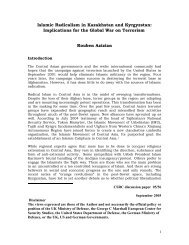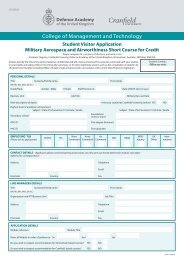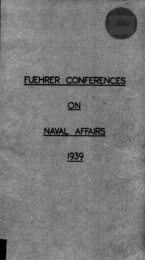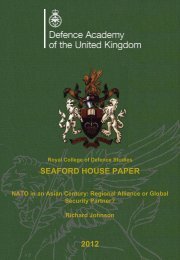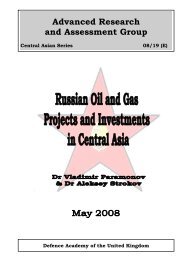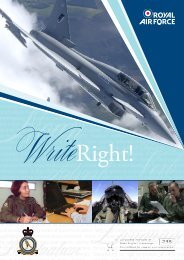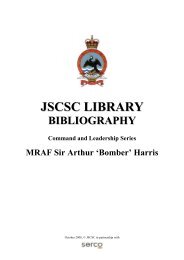Chapter 1
Chapter 1
Chapter 1
- No tags were found...
You also want an ePaper? Increase the reach of your titles
YUMPU automatically turns print PDFs into web optimized ePapers that Google loves.
HMS OCEAN, with Support Helicopters fromthe Joint Helicopter Command on deck
1Maritime Doctrinein ContextIn the Royal Navy, the existence of formal doctrine can be traced back tothe original edition of The Fighting Instructions, issued to the Fleet in1672, and to a code of tactical signals promulgated during theCommonwealth in 1653. The development of maritime tactical doctrine isthus a well-established process going back over 300 years. The RoyalNavy’s current operational and tactical doctrine is still promulgated in TheFighting Instructions and a wide range of supporting publications. Theseare also subjected to regular review as technology and equipment isdeveloped and enters into service and as a consequence of bothoperational experience and the analysis of operational and exerciseperformance. By its nature, much of this doctrine is specialised, isessentially the domain of those involved in operational and tacticaldecision-making and is not very widely disseminated. Indeed, manyaspects of operational and tactical doctrine are sensitive and are covered byappropriate security classifications.However, once we move up the hierarchy, from the tactical and operationallevels to the military- and grand-strategic levels, doctrine becomes less theexclusive business of the deep military specialists and more the legitimateinterest of any with a professional, academic, political or social stake in theuse of military power. There is also an especial need to recognise that, forreasons of motivation, morale, commitment and professional operationalunderstanding, junior military ranks need to have access to an1
BRITISH MARITIME DOCTRINE / THIRD EDITIONunderstanding and interpretation of the strategic context in which theirprofession is expected to operate.The emergence of military-strategic level maritime doctrine can be tracedback to the late nineteenth century and the early years of the twentiethcentury. Arguably, until the American Alfred Thayer Mahan applied hismind to the subject, there was little, if any, structured, academic thoughtgiven to the attributes of maritime power and how it might best be appliedin support of national interest. If one accepts the dictionary definition of‘doctrine’ as “that which is taught”, then the conclusions of Mahan andthose of a number of distinguished British maritime strategic thinkers couldbe credited with the doctrinal label. In the UK, perhaps none was soinfluential as Sir Julian Corbett, in particular the views he expressed in hisprofoundly important book Some Principles of Maritime Strategy. If,however, we restrict ‘doctrine’ to that which is officially promulgated, theonly higher level maritime doctrine that has been acknowledged officiallyin the UK has been that contained in the various editions of BR 1806. Thiswas originally called The Naval War Manual, its last appearance underthat title being in 1969 (previous editions dating from 1948 and 1958).In 1995, the new BR 1806 was published under a different title: TheFundamentals of British Maritime Doctrine (this became BritishMaritime Doctrine in the Second Edition). The new BR 1806complemented similar publications published by the Army and the RAF toform a stable of documents dealing with military-strategic level doctrine.Eventually, in 1996, the individual Services’ doctrinal books were joined bythe military-strategic level joint doctrine publication, British DefenceDoctrine (BDD), the second edition of which was published in 2001. BDDprovides the higher level framework from which operational level jointdoctrine cascades.A Joint ApproachMaritime doctrine as discussed in this book is not simply ‘naval doctrine’.While this edition of BR 1806 has been edited at the Maritime WarfareCentre under the auspices of the Naval Staff in the Ministry of Defence andis, in that sense, a single-Service statement of doctrine, it is not, nor could it2
MARITIME DOCTRINE IN CONTEXT1be, concerned solely with matters of a naval nature. The maritimeenvironment is inherently joint. Air power is as vital to operations at sea asit is to the conduct of military operations ashore. Naval forces themselvesexist to influence events ashore; they have never operated strategically inan exclusively naval environment. This book is not, therefore, about ‘seapower’. It is, rather, about the maritime dimension of joint operations. Anair force fighter aircraft and an army infantry battalion may well becomponents of a maritime force because the word ‘maritime’ refers to theenvironment in which they are operating, not to that institutional part ofthe UK’s armed forces that might be providing them.Since the Cold War the focus of maritime attention has shifted towardslittoral operations in support of operations ashore (arguably thisconstitutes a return to pre-Cold War circumstances). For this reason thereis an increasing emphasis placed on joint operations and the concomitantneed for each Service to understand the modus operandi of the other two.Joint operations in the littoral present a complex mix of opportunities andchallenges that will at times be difficult to meet. However, the Royal Navy’straditional flexibility of approach and its instinctive reliance on initiative toachieve maximum effect sit very easily with the manoeuvrist culture thatguides military operations today. Both the joint approach and manoeuvristthinking are essential elements of the British Approach to MilitaryOperations articulated in BDD.Despite the shift of focus towards the littoral, it is important that the deepwaterenvironment and the continuing need to be able to conduct openocean sea control operations are not neglected. For example, thesubmarine threat may have changed but it has not disappeared. The UK’smaritime forces must retain their ability to carry out effective antisubmarinewarfare (ASW) operations, especially in support of ballisticmissile carrying submarine (SSBN) deployments but also in the often(though not necessarily) shallower waters of the littoral. Maritime doctrineat all levels reflects operational imperatives in deep water as well as in thelittoral.3
BRITISH MARITIME DOCTRINE / THIRD EDITIONThe Purpose of Maritime DoctrineDoctrine is a framework of principles, practices and procedures, theunderstanding of which provides a basis for action. Maritime doctrinefulfils this function for the use of military power at and from the sea. Thedoctrine contained in this book covers principally the strategic and, to acertain extent, the operational levels of military planning, both in conflictand in the peacetime applications of military power. In general terms, themain purpose of maritime doctrine, at all levels, is to derive the greatestbenefit from current maritime forces in support of national policy.However, in achieving this aim it also serves a number of subsidiarypurposes.It has internal educational and training functions that contribute to theprofessionalism of the UK’s maritime forces and the men and women whoserve in them. There is a particular emphasis on the education of the officercorps and the Navy Board has instructed that all officers in the RN and RMshould undergo formal study of the fundamental principles of maritimedoctrine contained in BR 1806. This commences during New Entry coursesat Britannia Royal Naval College (BRNC), Dartmouth and the CommandoTraining Centre, Royal Marines (CTCRM), Lympstone and continues duringthe Initial Command and Staff Course (Maritime) (ICSC(M)) and AdvancedCommand and Staff Course (ACSC) at the Joint Services Command andStaff College (JSCSC), Shrivenham. By the time officers reach subsequentmid-career staff appointments, on Flag, Ministry of Defence or joint staffs,they should be familiar with the principles underlying the use of maritimepower. All officers receive a personal copy of the book and all warrantofficers on promotion are also made aware of its contents.In so far as it produces a way of thinking about the utility of maritime powerand the conduct of operations, doctrine also has a professionalmotivational function through providing maritime forces with clearstatements about their roles and objectives. At the military-strategic level,doctrine also informs the wider defence community (including politicians,industrialists, academics, etc), as well as interested members of the generalpublic, about the roles and political utility of maritime forces.4
MARITIME DOCTRINE IN CONTEXT1The Equipment Capability Customer in the MoD uses a centrally endorsedterminology called the Equipment Capability Taxonomy to articulate apractical definition of military and equipment capability and the strategic,operational and tactical effects desired from new equipment. These differfrom doctrinal concepts that are used for strategic or operational planning.However there is an important role for doctrine, particularly that at themilitary-strategic level, in informing the higher level definition ofequipment capability and the particular operational effect required. Inexamining the overall utility of a joint asset (an aircraft carrier, for example)it is necessary to assess its characteristics and likely employment in relationto doctrinal principles applicable in all relevant operational environments.The Nature of DoctrineWithin the UK’s armed forces the general definition of military doctrine isvery similar to that used in NATO. To quote BDD, it is: “fundamentalprinciples by which military forces guide their actions in support ofobjectives. It is authoritative, but requires judgement in application”. Thesecond part of this definition is intended to convey the message thatdoctrine should not develop the rigid authority of dogma but shouldremain flexible.Doctrine must be flexible in two senses, therefore. First, it must convey theimportance of initiative and not discourage commanders from challengingreceived wisdom when appropriate. Second, it must be subject to regularformal review to ensure that the accumulated wisdom being promulgatedin the form of doctrine is as robust and relevant as possible. However, inconducting regular review, care must be taken not to make change forchange’s sake. At the military-strategic level, the fundamental principleswill probably change only very rarely. In contrast, at the tactical level,doctrine will clearly be directly affected by current challenges andcapabilities; tactical doctrine is equipment, threat and environment driven.The Hierarchy of DoctrineMaritime doctrine does not exist in a vacuum. As has already beenmentioned above, BR 1806 is but one of a stable of higher level doctrine5
BRITISH MARITIME DOCTRINE / THIRD EDITIONpublications. For a thorough understanding of the ways in which militaryforces are utilised in support of national policy there is no substitute forstudying the range of doctrinal publications now available. At the militarystrategiclevel, UK doctrine is articulated principally in British DefenceDoctrine. BR 1806, ADP Land Ops, and AP 3000 (British Air PowerDoctrine) each provides an environmental perspective on doctrine at thehigher levels (military-strategic and operational). The principal capstoneoperational level document is JDP 01, Joint Operations. As far asmaritime doctrine is concerned, for those with access to it, there is also TheFighting Instructions at the operational and tactical levels, which sitsimmediately below BR 1806. There is a form of symbiosis existing betweenall such documents and the development of maritime doctrine through thepublication of this book will have an influence on the development of theothers.Finally, the importance of NATO doctrine, while it exists in a separatehierarchy outside that for UK national doctrine, must be acknowledged. Agreat deal of the doctrine applied at the operational and tactical levels bythe UK’s maritime forces is agreed with Allies and promulgated in NATOpublications. It is UK policy that its national doctrine should be consistentwith NATO doctrine other than in those exceptional circumstances whenthe UK has elected not to ratify the relevant NATO doctrine. With the UK asthe principal European maritime power, UK influence on the developmentof NATO maritime doctrine is profound; so much so, indeed, that a similarsymbiosis exists between UK and NATO maritime doctrine to that whichexists between UK maritime doctrine and other publications in the UKnational doctrinal hierarchy. A similar linkage also exists between NATOand UK joint doctrine.Levels of Military OperationsBDD recognises the different levels at which decisions are made and atwhich operations are conducted. They include the grand-strategic,military-strategic, operational and tactical levels. BR 1806 promulgatesmaritime doctrine at the military-strategic level but in so doing alsodiscusses relevant aspects of the operational level. As already stated, theRN’s operational and tactical levels of maritime doctrine are promulgated in6
MARITIME DOCTRINE IN CONTEXT1The Type 23 frigate HMS NORTHUMBERLAND escorts aTRAFALGAR Class nuclear powered submarineThe Fighting Instructions and other national publications, with muchadditional tactical doctrine contained in NATO publications.At each level, consideration has to be given to the types of operations thatare to be conducted and the extent to which force needs to be applied toachieve political and military objectives. Ultimately, the UK’s maritimeforces must be capable of operating within the extremes of violence typicalof those associated with general war. While general war is currently7
BRITISH MARITIME DOCTRINE / THIRD EDITIONconsidered to be an unlikely eventuality, the intensity of violence associatedwith it cannot be dismissed to the same extent. High intensity operationsmay be required to achieve success in conditions falling well short ofgeneral war. Maritime forces must be able to function in high intensitysituations and survive them in order to ensure success. The tendency forlower intensity operations to escalate, and for original limited objectives toexpand, means that reserves of combat capability will be necessary toprovide higher level decision-makers with an adequate range of options.Maritime forces must, therefore, be equipped and trained to allow forescalation to a higher intensity of operations than those for which they mayoriginally have been deployed, consistent with the central philosophy ofthe British approach to military operations in the round; namely thatretention of a warfighting ethos is central, ready to be applied if thecircumstances demand it.The Influence of Law on Maritime OperationsRegardless of the level, intensity and type of maritime operations beingconducted, including routine peacetime activities, they must be carried outwithin the limits imposed by international law and, where appropriate,within the limits imposed by either UK domestic law or that applying inother jurisdictions. Notwithstanding the inherent right of self defence,legal restraints on all maritime operations will be reflected in the Rules ofEngagement (ROE). Royal Navy warships invariably operate withpromulgated ROE, including during the conduct of routine peacetimeactivities.1/1. The Principles of WarEssential to the art of military leadership and command is the ability tolearn from one’s own experience and that of others. The Principles ofWar are a distillation of experience and a simplification of complex andsometimes contradictory ideas. They are broad precepts for theconduct of armed conflict. They should be used to inform all militarystrategic and operational decisions rather than as a planning checklist.The ten Principles recognised by the armed forces of the UK are8
MARITIME DOCTRINE IN CONTEXT1described in detail in BDD. They are illustrated below, in the context ofthe campaign to regain the Falkland Islands in 1982, by Admiral Sir John‘Sandy’ Woodward GBE, KCB, the Commander of the Falklands BattleGroup:The Selection and Maintenance of the AimThe initial aim was stated as “Prepare to land with a view torepossessing the Falklands” about one week after the Argentineansinvaded. It was changed to “Repossess the Falklands” on May 12th.While the first aim could, at least in theory, have been met withoutgetting up from one’s armchair, it was 42 days before a simple, clear aimwas given. Events up to that time reflected the excessive vagueness ofthe first aim and the consequences of that vagueness. Eventssubsequent to 12th May reflected the importance of having a clearlystated aim as early as possible. However, it was not easy, mainly onpolitical grounds, to be more definite much earlier. The military plan,only developed and disseminated on April 17th, had repossession verymuch in mind and, for a range of reasons, assumed an end date to thecampaign of June 14th. As far as ‘maintenance of the aim’ isconcerned, the campaign would appear to have been a classic examplesince it was achieved on the precise date forecast!Maintenance of MoraleQuite a problem, aggravated by ‘war’ never being declared or over.However, morale was maintained by all the usual means withoutmaking any special efforts. My own general theme was ‘Don’t concernyourselves too much about why we are going down, or even whetherwe will get away with it if it does come to war, just do the very best youeach can, if nothing else that is your best chance of survival’. The extentto which this approach was successful is probably best judged by theremark of one Senior Rate from HMS COVENTRY who came up to meback in UK later and said “You always knew we were going to be sunk,didn’t you?”9
BRITISH MARITIME DOCTRINE / THIRD EDITIONOffensive ActionThe very nature of the operation had perforce to be offensive. Thedifficulty was to know what offensive, or defensive, activities would besuccessful in a largely untried-in-war force essentially trained for acompletely different kind of war. Consequently, the early stages afterentering the Exclusion Zone were frequently experimental in nature onthe basis that depending on results, we would reinforce success andretire from failure. Wherever possible, the initiative was retained whilewe tried to find out what worked best.SecurityThe main problem was the media, who with cameras on the spot wereinitially slow to understand the requirements. This was also a majorproblem in press releases at home. The pastoral need to advertise thesinking of a warship was seldom/never weighed against the freedamage assessment handed to the enemy. For instance, theArgentineans had no way of knowing whether their first Exocet attackhad worked until the information about HMS SHEFFIELD was releasedin London. As for Force Protection, it is clear that we had enough, just.The sinking of the BELGRANO, while it did in fact, defeat theArgentinean Navy, could never be assumed to have done so, even afterJune 14th. It is only in the light of subsequent events that the effect ofBELGRANO became apparent. I personally do not feel that I ever felt Ihad adequate security from start to my own finish on about July 3rd. Iwas always very conscious that the Argentineans could come againwith just four A4s and ruin our day if we got careless and they got lucky.HERMES, then INVINCIBLE stayed well out at sea at nearly all timesincluding the months after the land battle finished. It should beremembered that not only was no war declared at the beginning, nopeace was ever declared after the main fighting was over. That said,lack of security must not allow you to be ‘frozen’ in your plans andoperations.10
MARITIME DOCTRINE IN CONTEXT1The Type 42 destroyer HMS SHEFFIELD, damaged by an Exocet missileduring the Falkland Islands conflict, 4 May 1982SurpriseSurprise, often an important part of effective offensive action, wasimpossible to achieve in strategic terms. The enemy knew exactly whatwe hoped to do. At the tactical level, a degree of surprise was achievedin almost every area, usually preceded by substantial deception.Deception was used during the approach to the area (18th-30th April)to convince the Argentineans that we were coming straight in to theStanley area for landing on May 1st/2nd. This was successful, drawingout the Argentinean navy and, less successfully their air force for twodays, to attack us. It did much to defeat the Argentinean navy andconvince us that the Sea Harrier was an effective interceptor after all.After that and before the landing, deception was used in ChoiseulSound to make it look as if we might land there. Deception was also11
BRITISH MARITIME DOCTRINE / THIRD EDITIONused in all air operations from the carriers to disguise the Battle Group’sposition. Surprise was achieved in the main landing itself in San CarlosWater, in the Pebble Island raid (where the airstrip was virtuallyundefended), and in most land force attacks.Concentration of ForceThis was kept constantly in mind but was extremely difficult to achieveduring the passage South as units were detached for other operationsthroughout the approach phase (HMS BRILLIANT Group, OpPARAQUAT). Thereafter it was kept constantly in mind despite the clearneed to split forces at the landing phase.Economy of EffortThis was always a battle requiring the maximum economy of effort. Thebattle hung in the balance throughout, whatever it may have seemed athome. Assets were invariably in short supply. For example, we startedwith only some 24 fixed-wing interceptors, over half of which had onlya day intercept capability. One only was lost to enemy action and five toaccidents. Reinforcement by limited RAF GR3 assets was critical to takethe ground attack load off the Sea Harrier force remaining. Time andweather were against us. Re-supply routes were long. We only had twoaircraft carriers in fleet service - during war operations, both wererequired ‘up front’ with no reserve. As an indication of the ‘economy ofeffort’, on about 12th June, the Battle Group had only one of sevenchannels of Sea Dart fire serviceable, no ASW Sea Kings in the role(some were sent inshore to assist land forces, the rest were doing whatlittle they could to act as surface search and AEW), and the followingevening, of four DD/FF requested for night operations in support of landforces, only two could get in and one of those had a shaft locked.‘Paucity’ was more the word than ‘economy’.12
MARITIME DOCTRINE IN CONTEXT1FlexibilityBearing in mind that the Royal Navy had been training and equippingitself solely for an anti-submarine battle against the Warsaw Pact forcesin the North Atlantic for over a decade and that it had not envisaged asupported amphibious operation for 20 years at least, switching to ananti-air, anti-surface battle in support of an offensive amphibiousoperation the other side of the world does imply a substantial degree offlexibility. Other examples of flexibility were a straight-off-the-cuffcommand organization at Northwood; first use of DSSS securecommunications in major operations; re-write against the clock of Rulesof Engagement; Ships Taken up from Trade in general and ATLANTICCONVEYOR in particular (until sunk on 25th May, she consideredherself almost a third aircraft carrier); use of RFAs as missile decoys; useof SSNs for air raid warning; use of T22/T42 combination in attempt tooptimise interdependence of Sea Dart and Sea Wolf; Lynx were used asExocet decoys; frigates were used for anything and everything fromtheir many accepted roles to AD pickets, decoys, and even minehunters.Co-operationCommodore Amphibious Warfare (COMAW) would say that he gotlittle co-operation from the Battle Group Commander. The BattleGroup Commander would say that he gave COMAW absolutelyeverything he could possibly spare and then some (see comments on‘economy of effort’ above). Viewed more objectively, co-operation wasforce-wide but not without occasional and natural angst. Theimportant thing to hang on to is that co-operation was entirelyadequate to get the job done in the face of considerable odds.13
BRITISH MARITIME DOCTRINE / THIRD EDITIONSustainabilitySustainability was critically reviewed on 17th April. From thatassessment, the operational plan was laid out for the next two months.It assumed that fleet sustainability for war operations should lastadequately until mid-June, although there were several majorunknowns eg Sea Harrier effectiveness and serviceability over anextended period. Thereafter, we expected to be on an uncomfortablysharp downward trend. Events proved the assumption correct, to theday, even with the loss of Atlantic Conveyor, which was a very majorsetback for the land forces (75% of their helicopter lift - not to mentionmuch else - went down with her). Sustainability after the end of theland battle was much less of a problem and largely confined to thecontinued health of the remaining Sea Harrier force supported by onecarrier offshore.14
MARITIME DOCTRINE IN CONTEXT1Victorious Royal Marines in Port Stanley, Falkland Islands, June 198215



